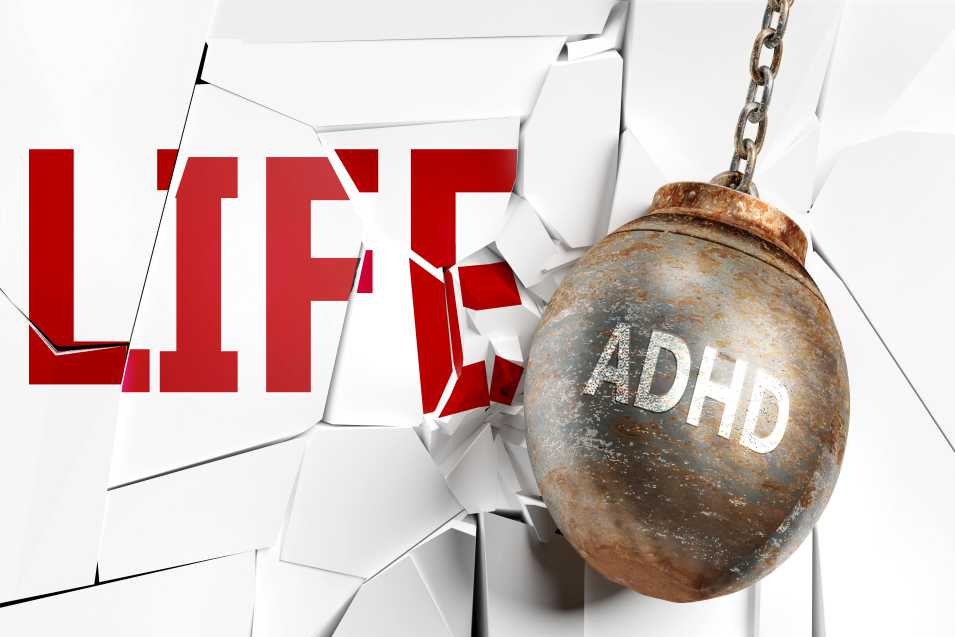
Have you ever wondered about the intricate relationship between object permanence and attention deficit hyperactivity disorder (ADHD)? This article delves into this intriguing connection, shedding light on how individuals with ADHD perceive and retain the concept of object permanence. By exploring this topic, we aim to grasp a deeper understanding of the cognitive processes underlying ADHD and its impact on daily life.
Object permanence refers to the ability to understand that objects continue to exist even when they are out of sight. It is a fundamental cognitive skill that develops during early childhood. However, research has suggested that individuals with ADHD may struggle with aspects of object permanence, leading to difficulties in organizing their environment and maintaining focus.
One key aspect contributing to this connection is working memory, which involves temporarily holding and manipulating information in mind. Individuals with ADHD often exhibit impairments in working memory, making it challenging for them to retain the presence of objects in their mental space. This can result in frequent misplacing of belongings, forgetfulness, and disorganization.
Moreover, executive functions play a crucial role in the relationship between object permanence and ADHD. Executive functions encompass a set of cognitive processes responsible for planning, organizing, and regulating behavior. Deficits in these functions can hinder the ability to maintain object permanence, affecting everyday activities such as following instructions, completing tasks, and staying focused.
Understanding the link between object permanence and ADHD has important implications for interventions and support strategies. By recognizing the specific challenges faced by individuals with ADHD, tailored approaches can be developed to enhance object permanence skills. These may include visual cues, organizational aids, and memory-enhancing techniques that help reinforce the concept of object permanence.
the connection between object permanence and ADHD sheds light on the cognitive complexities experienced by individuals with this condition. By comprehending how object permanence is affected in ADHD, we can better address the unique needs of individuals with this neurodevelopmental disorder. Continued research in this area holds promise for improved interventions and enhanced quality of life for those living with ADHD.
‘Decoding the Puzzle: The Link Between Object Permanence and ADHD’
Rakamların ve sembollerin dünyasında yaşanan renkli bir patlama, nesne kalıcılığı ve dikkat eksikliği hiperaktivite bozukluğu (DEHB) arasındaki ilişkiyi çözmenin anahtarını sunuyor. Genellikle çocuklarda görülen DEHB, odaklanma güçlüğü, hiperaktivite ve dürtüsellik gibi belirtilerle kendini gösterir. Ancak son araştırmalar, bu bozukluğun altında yatan daha karmaşık bir bulmacanın olduğunu ortaya koyuyor.
Nesne kalıcılığı, bebeklik döneminde kazanılan bir bilişsel yetidir. Bu yeti, bir nesnenin gözden kaybolduktan sonra bile var olduğunu anlama becerisini ifade eder. Örneğin, bir bebeğe bir oyuncağı gizlersek, normal bir gelişim gösteren bebek, oyuncağın hâlâ var olduğunu bilir ve onu aramaya başlar. Bu, nesne kalıcılığı olarak adlandırılan temel bir bilişsel işlemdir.
Son araştırmalar, DEHB olan çocukların nesne kalıcılığı becerilerinde zayıflama olduğunu ortaya koymaktadır. Bu durum, DEHB'nin sadece dikkat eksikliği ve hiperaktiviteyle ilgili bir sorun olmadığını, aynı zamanda bilişsel işleme de etki ettiğini gösteriyor.
Neden DEHB olan çocukların nesne kalıcılığı becerilerinde sorunlar olduğu henüz tam olarak anlaşılamamıştır. Bununla birlikte, bazı araştırmacılar, beyin bölgeleri arasındaki iletişimdeki eksikliklerin bu duruma katkıda bulunabileceğini düşünmektedir. Beyindeki önemli kontrol mekanizmalarının etkilenmesi, nesne kalıcılığı sorunlarına yol açabilir ve DEHB semptomlarını daha da kötüleştirebilir.
Bu yeni bulgular, DEHB'nin sadece dikkat eksikliği ve hiperaktiviteyle sınırlı olmadığını vurguluyor. Nesne kalıcılığı gibi bilişsel yeteneklerin değerlendirilmesi, daha kapsamlı bir tedavi yaklaşımının geliştirilmesine yardımcı olabilir. İleride, DEHB olan çocukların bilişsel işlevlerini iyileştirmeye yönelik özel müdahalelerin nasıl olabileceği konusunda daha fazla araştırma yapılması gerekmektedir.
Böylece, nesne kalıcılığı ve DEHB arasındaki bağlantıyı çözme yolculuğunda yeni bir parça eklenmiş oldu. Bu keşif, çocukların zihinsel yeteneklerini anlamak ve DEHB'nin karmaşıklığını açıklamak için önemli bir adımdır. Gelecekteki çalışmalar, bu bulmacadaki diğer parçaları keşfetmeye devam ederek daha bütünsel bir resim ortaya çıkarabilir.
‘Inside the Mind: Unraveling the Mystery of Object Permanence in ADHD’
Makale:
Dikkat Eksikliği Hiperaktivite Bozukluğu (DEHB) çocukları için nesne kalıcılığı, bilişsel bir yetenek olarak büyük bir gizem haline gelmiştir. Nesne kalıcılığı, nesnenin görüş alanı dışına çıktığında bile var olduğunu anlama yeteneğidir. Bu makalede, DEHB ile ilişkili nesne kalıcılığı zorluklarını daha iyi anlamak amacıyla bu konuya daha derinlemesine bakacağız.
DEHB'li çocukların, nesne kalıcılığı becerilerinin tipik olarak gelişme gösteren akranlarına kıyasla zayıf olabileceği bulgularından yola çıkarak, araştırmacılar, bu durumun DEHB'nin temel özelliklerinden biri olabileceği hipotezini ortaya atmıştır. Nesne kalıcılığı, bilişsel süreçler ve işitsel-geçici bellek yetenekleriyle de bağlantılıdır, bu da DEHB'nin genel bilişsel işleyişini etkileyebileceğini düşündürmektedir.
Araştırmalar, DEHB'li çocukların nesne kalıcılığı görevlerinde daha fazla hata yaptığını ve nesnelerin yok olduğunu anlama konusunda zorluk yaşadığını göstermektedir. Bu durum, DEHB'nin dikkat ve bilişsel işleme sorunlarına bağlı olarak nesnenin kalıcılığını takip etme yeteneğini olumsuz etkileyebileceğini düşündürmektedir.
DEHB'li çocuklar için nesne kalıcılığı becerilerini geliştirmek için çeşitli stratejiler kullanılmaktadır. Örneğin, yapılandırılmış oyunlar ve eğitici materyaller kullanılarak nesne izleme yetenekleri teşvik edilebilir. Ayrıca, dikkatlerini daha iyi odaklamalarına yardımcı olmak için ödül sistemleri ve görsel ipuçları da kullanılabilir.
nesne kalıcılığı DEHB'nin bir alt bileşeni gibi görülebilir. DEHB'li çocukların bu beceriyi geliştirme konusunda zorluk yaşaması, bilişsel süreçlerdeki bozukluklarla bağlantılı olabilir. Bu alanda daha fazla araştırma yapılması, DEHB'nin bilişsel işlevler üzerindeki etkisini daha iyi anlamamıza yardımcı olabilir ve nesne kalıcılığı becerilerini iyileştirmek için daha etkili tedavi yaklaşımlarının geliştirilmesine katkıda bulunabilir.
Bu makalede, DEHB ile nesne kalıcılığı arasındaki ilişkiyi anlamaya çalıştık. Nesne kalıcılığının DEHB'li çocukların bilişsel işlevlerindeki zorluklara katkıda bulunabileceği düşünülmektedir. Ancak, bu alanda daha fazla araştırma yapılması gerekmektedir.
‘ADHD and Object Permanence: Building Bridges to Better Understanding’
Attention-Deficit/Hyperactivity Disorder (ADHD) is a neurodevelopmental disorder that affects both children and adults, causing difficulties in maintaining attention, impulsivity, and hyperactivity. However, there is another aspect of ADHD that often goes unnoticed—object permanence. In this article, we will explore the relationship between ADHD and object permanence, shedding light on this lesser-known aspect of the disorder.
Object permanence refers to the understanding that objects continue to exist even when they are out of sight. It is an essential cognitive skill that develops during infancy. However, individuals with ADHD may struggle with this concept throughout their lives. The challenges associated with object permanence can manifest in various ways. For instance, individuals with ADHD might frequently misplace or lose items due to their difficulty in mentally tracking objects and remembering where they put them.
This struggle with object permanence can have significant implications for individuals with ADHD. It can lead to frustration, increased stress levels, and difficulties in organizing and managing daily tasks. Understanding this aspect of ADHD is crucial, as it allows us to provide targeted support and interventions to help individuals navigate these challenges effectively.
Building bridges to better understanding involves acknowledging the unique needs of individuals with ADHD regarding object permanence. Adopting strategies such as creating visual cues, implementing consistent routines, and using organizational tools can greatly assist in compensating for the difficulties associated with object permanence. By providing external aids and structure, individuals with ADHD can enhance their ability to keep track of their belongings and maintain a more organized and structured environment.
Moreover, it is important for educators, parents, and caregivers to be aware of the impact that object permanence challenges can have on individuals with ADHD. By fostering empathy, patience, and understanding, we can create a supportive environment that facilitates their learning and development.
ADHD and object permanence are intricately connected. By recognizing and addressing the challenges related to object permanence in individuals with ADHD, we can empower them to overcome these difficulties and achieve their full potential. Through increased awareness and targeted interventions, we can build bridges to better understanding and support for individuals with ADHD, ultimately improving their quality of life.
‘The Invisible Thread: Examining the Connection between ADHD and Object Permanence’
ADHD, or Attention Deficit Hyperactivity Disorder, is a neurodevelopmental disorder that affects both children and adults. It is characterized by symptoms such as inattention, hyperactivity, and impulsivity. While these are well-known aspects of ADHD, there is another intriguing aspect that often goes unnoticed: the connection between ADHD and object permanence.
Object permanence is the understanding that objects continue to exist even when they are not in sight. It is an important cognitive milestone that typically develops in early childhood. However, studies have suggested that individuals with ADHD may experience difficulties with object permanence, leading to various challenges in their daily lives.
One way in which ADHD can manifest in relation to object permanence is through forgetfulness. Individuals with ADHD may struggle to remember where they placed everyday items, such as keys or wallets. This forgetfulness can be attributed to difficulties in maintaining a mental representation of the object's location when it is not directly perceived.
Moreover, individuals with ADHD may exhibit impulsive behavior when it comes to objects. They might misplace or lose belongings more frequently than those without ADHD. This impulsive behavior could stem from an underlying difficulty in forming a coherent mental image of the object and its proper place.
Interestingly, the connection between ADHD and object permanence extends beyond physical objects. It also affects social interactions. Individuals with ADHD may have trouble maintaining friendships or romantic relationships due to their difficulties in perceiving the lasting presence of others in their lives. This can lead to feelings of isolation and frustration.
Understanding the link between ADHD and object permanence is crucial for developing effective strategies to support individuals with ADHD. Therapeutic interventions and educational approaches can be tailored to address the specific challenges faced by individuals with ADHD in terms of object permanence. By recognizing and addressing these difficulties, it is possible to enhance their overall well-being and quality of life.
the invisible thread between ADHD and object permanence sheds light on a lesser-known aspect of this neurodevelopmental disorder. Difficulties in remembering object locations, impulsive behavior related to objects, and challenges in social interactions all demonstrate the impact of ADHD on object permanence. By delving deeper into this connection, we can pave the way for improved understanding, support, and interventions for individuals with ADHD.
